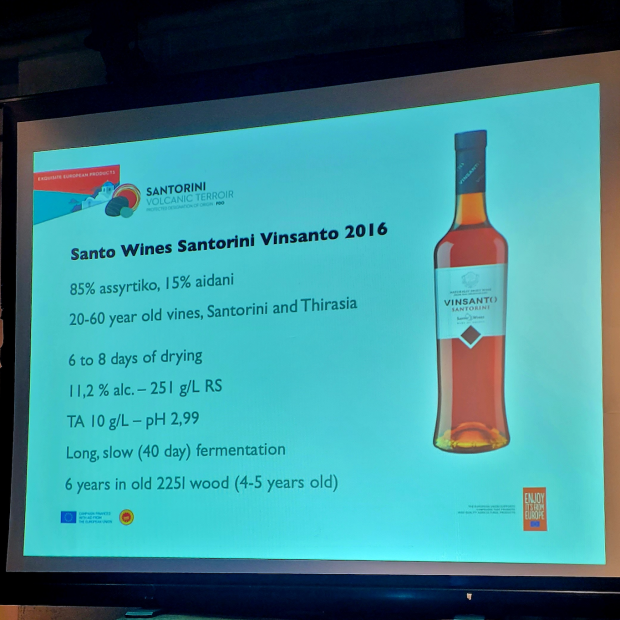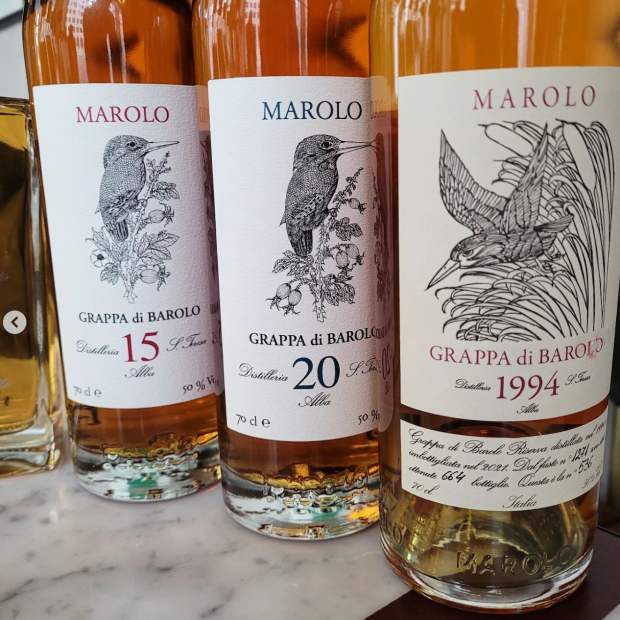I have not made a volcanic pilgrimage to Greece in some time and so happy times abound when the basaltic magma terroir of Santorini comes to town. A George Restaurant welcome to four archetypal producers stamped a guarantee for a great tasting day back in May, first and foremost through a masterful masterclass as an in depth look at PDO Santorini. This was followed by a meet and greet with more of that volcanic island’s wines, their collective bar raised by Chef Lorenzo Loreto’s always creative snacks. All the thank-yous go out to Sofia Perpera of Wines of Greece, my colleague John Szabo M.S., the importing agents here in Ontario and of course the visiting producers. There were 11 PDO Santorini wines poured for the class and these are my notes.
Santo Wines Assyrtiko Organic 2022
Should likely be immovable when this young in an assyrtiko prominently phenolic as it is defined by its dry extract. The vines are 60-80 years old from Pyrgos, Eco Gonia, Faros Akrotiriou and Imerovigli. Alcohol generous but not exaggerated at 13.2 while both acidity (6.1 g/L) and pH (2.91) are on the low end of the assyrtiko spectrum. Solid and exemplary cooperative wine, representative of 50 per cent of the entire production of the island. As much a matter of tang as it is volcanic originated salinity. In the end this is preparing for readiness to drink well ahead of most of the island’s varietal wines. Drink 2023-2025. Tasted April 2023
Domaine Sigalas Assyrtiko 2022
Vines are 60-plus years of age and the assyrtiko juice ages three months in only stainless steel with “occasional” bâtonnage. Alcohol is a reflection of a prolific vintage and acidity is on the low side while conversely pH sits higher, above three. Makes for a sapid assyrtiko which of course can also be salty but this is surely more a matter of texture by a wine that wholly, fully and completely covers the entirety of the palate. Drink 2023-2026. Tasted May 2023
Seventy to 80 year-old vines, stratospheric acidity and bold alcohol make for a dichotomous assyrtiko that also expresses clean, grapefruit and white peppery reduction. Strictly stainless steel aged accompanied by necessary lees addendum and this was handled so properly to ride the new wave stylistic. The mouthfeel is extraordinary, the wine is predicated on texture, just now getting ready to roll but also capable of aging well. Drink 2023-2027. Tasted May 2023
The Estate by Argyros, largest of the private producers on Santorini is the most generous and substantial of them all. Everything is elevated in this gregarious wine coming from 100-120 year-old untrained bush vines. Big alcohol towards 14 and a half percent, leading towards high acidity but also grander of pH. These are not white wines subjected to vintage variation so this is indeed the norm for assyrtiko and Santorini. This is quite honestly the centre of the Santorini universe and no other wine represents with more estate esteem than this teachable one. Drink 2024-2029. Tasted May 2023
Argyros Estate Cuvée Monsignori 2020
Do not adjust your set but yes this is assyrtiko from 200-plus year-old vines growing in the central-south area of Episkopi. Specs are actually quite similar to the Estate but the dry extract level is just about 25 which is extraordinary for white wines anywhere. Longer lees aging of 11 months between harvest is necessary to keep up with the concentration and intensity of this unicorn assyrtiko. Salinity and volcanic interpretation are off the charts. Easily one of the top white values on the planet. Drink 2025-2034. Tasted May 2023
Gaia Assyrtiko Wild Ferment 2021
Assyrtiko through and through, vines 70-80 years of age with three century root systems. Big, high acid and also relatively elevated with pH above three. Wild ferment and wood three ways; French, Acacia and American, all 225 size barriques. Flinty, barrel effected now but enough subtlety to tell us that integration will be done and without complication. This assyrtiko really settles upon and melds with the palate, like a dissolving salve of light caramel, fennel pollen and fiddlehead dust. Herbal and then lemon all over the back end, with a taste of just faintly caramelized meringue. Drink 2025-2031. Tasted May 2023
Santo Wines 1911 Santorini Nykteri 2021
Nykteri is 85 percent assyrtiko (the minimum for the Santorini PDO) with (10) athiri and (5) aidani. Vines are 50 years of age from the “other” growing area, that being Oia. Really rich, viscous and fulsome white blend, more phenolic and softer than the 100 percent assyrtiko. Different and curious, certainly a matter of vintage in terms of sappy and resinous qualities. Drink 2023-2026. Tasted May 2023
Only assyrtiko, 60 year-old vines, high alcohol and relatively higher pH at 3.11. A naked example in 10 percent new, 90 percent used wood. Beautifully integrated already and a wine that’s more ruminative than most others but also expressly sapid, crunchy and as the Italians would call scorrevole. Warm up to this wine and its generous if also nurturing style. Drink 2024-2028. Tasted May 2023
Vinsanto, wine of Santorini in its original form though not likely aged in ancient clay pots. Grapes are dried six to ten days and aged two years in barrel. Alcohol is quite low at just above 11 while the residual sugar runs high, at 251 g/L/. Spent six years in 225L barrels for a wine of caramel delight with other concentrated parts, especially acids, running at 10 g/L. Salty, not surprising, so yes a taste of salted caramel though and the feeling of a sunset landing into the sea behind whitewashed Oia. To great applause. Drink 2023-2033. Tasted May 2023
Now going back to 2012 it is Gaia’s aged 10 years in the same one-year old barrels the wine was fermented in. The vines are 70-90 years of age for a 10 percent combination of athiri and aidani compliment to assyrtiko. Just under 11 alcohol with great acid and also pH. These grapes are half sun and half shade dried for two weeks. Incredible concentration, intensity of all parts layered but with a tempering of the structural zones that mitigate any chance of cloy by overpowering sugars. Also some bitter phenols which suggests that chocolate would be a good match, so long as it’s a bit bitter and perhaps the same idea from espresso. Hard cheeses as well so a desert wine here that can cycle through savoury connections. Drink 2023-2036. Tasted May 2023
Argyros Estate Vinsanto Late Release 2002, PDO Santorini
First wild aspect of note is the 324 count in dry extract, more than 10 times the number of the most austere Barolo ever made and then the 290 g/L of residual sugar – while acidity is relatively lower and pH really elevated. If a Vinsanto could ever be considered and called sapid this would be the one, This assyrtiko with 10 percent each athiri and aidani comes from Argyros’ 200-plus year-old vines located in Episkopi. This is a Vinsanto that should and must be tipped alongside savoury courses and there could never be a mistake in that course being centred by salty cheese. The wine finishes with that metallic taste of iron that lingers on the palate for minutes on end. Drink 2023-2027. Tasted May 2023
Good to go!
godello
Twitter: @mgodello
Instagram: mgodello








